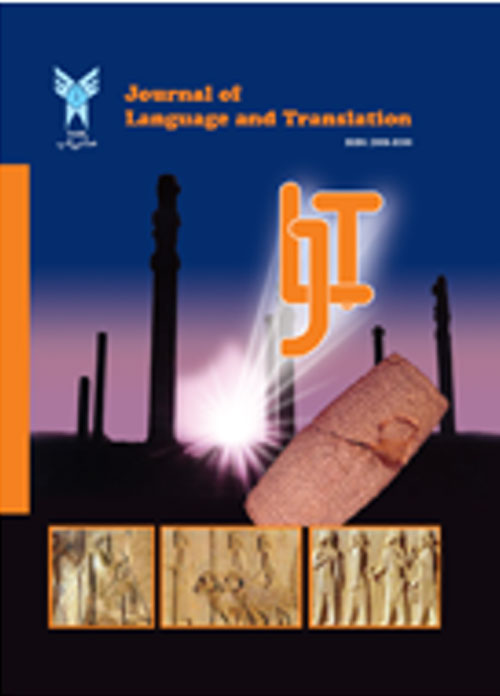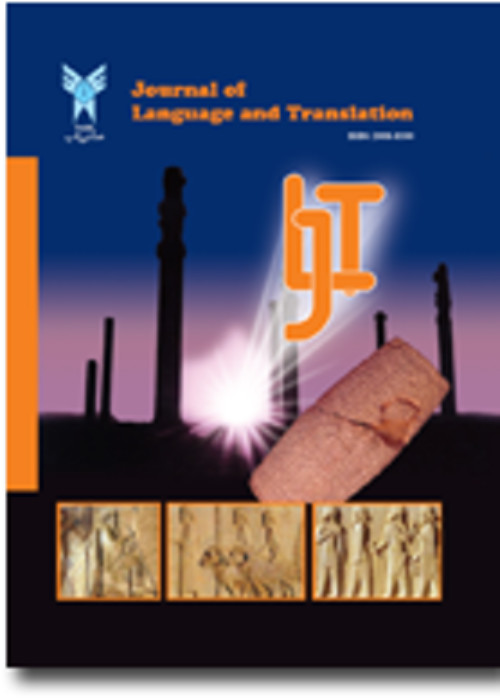فهرست مطالب

Journal of Language and Translation
Volume:7 Issue: 4, Winter 2017
- تاریخ انتشار: 1396/12/25
- تعداد عناوین: 6
-
-
Pages 1-20The present research study aimed to explore covert processes of editing and revision which were involved in writing four different academic text genres (i.e. abstract, conclusion, data commentary, and cover letter) in English language. To this end, six EFL learners with Persian as their mother were recruited to participate in this study. All the participants attended an induction session and each individual participant was invited to attend four writing sessions (total of 26 sessions for all 6 participants). Think-aloud protocol was employed for participants to verbalize all their thought processes, including stray notions, false starts, and incomplete or fragmentary thoughts, while performing the composition tasks. All the writing sessions were video-recorded and the participants were asked to insert their texts in Microsoft Word, which was in fact linked to the keystroke logging program, that is, Inputlog. The composition tasks were then dropped into Inputlog software to trim (i.e. reconstruct text production). The collected data were analyzed using qualitative content analysis as an interpretation and analysis method based on a three-step procedure proposed by Strauss and Corbin in grounded theory (open coding, axial coding, and selective coding). The results offered four main processes of planning, formulating, evaluating, and reformulating. The reformulating process was further subdivided into editing and revision. To draw a more accurate comparison between the processes, the researchers needed to resort to a statistical apparatus and run the Test of Chi Square. The results of chi-square indicated that there were significant but weak differences between the processes of editing and revision among different text genres. The results of the study would contribute to an understanding of how writing, editing and revising processes could integrate the learners into the process of academic writing.Keywords: Academic text Genres, Editing, Inputlog, Revision, Think, aloud protocol
-
Pages 21-31The impact of animated cartoons on children has already been emphasized by quite many researchers. The present study aimed to investigate the strategies Iranian subtitlers of English animated cartoons used in re n- dering English anthroponyms in cartoons. To this aim, two theoretical frameworks were employed: Van Coillie's Model of Translating Proper Names and Fernandess Model of Proper Names Translation. The aim was to find which strategies were the most prevalently used by Iranian subtitlers of cartoons and to see which model fitted these attempts best. Five car toons were investigated: Ben 10, Ninja Turtles, Kung Fu Panda, Spider Man, and Dream Works Dragons. Through a qualitative content analysis, distribution of strategies was found and reported in frequencies and percentages. They were cross - compared between t he two models. The results showed that quite a few strategies of each model were used. The only strategy, which was dominantly used by Iranian subtitlers in all cartoons was termed as Reproduction or Copy which was the least demanding on the part of the tr anslator. Many strategies were left unapplied which could be explained by Iranian subtitlers sheer unawareness of a variety of strategies for translating anthroponyms.Keywords: Anthroponym, Cartoons, translation
-
Pages 37-47The present study was an attempt to investigate the significance of environmental changes on the develo p- ment of writing in English as a Foreign Language (EFL) context with respect to the individual. This study also compared the impacts of collaboration and asynchronous computer mediation (ACM) on the writing complexity of EFL learners. To this end, three intact writing classes were designated as Collaborative face - to - face group (N = 21), Asynchronous Computer Mediation group (N = 20) and Control group (N =16). The two experimental groups received scaffolding instructio ns on narrative essays. The collaborative face - to - face group (CFFG) went through the working in pairs, and working asynchronously through a researcher - designed website (ACMG). The data were analyzed employing ANOVA. The results showed that CFFG improved in terms of complexity and positive impact of Collaborative approach and superb performance of CFFG over the ACMG. The findings brought to light the benefits of pair work and showed that learners working in pairs used structures that were more complex in the ir writing than ACM class.Keywords: Asynchronous computer mediation, Collaboration, Complexity, Mediating artifact, Scaffol d, ing instruction, Writing performance
-
Pages 49-64Translation is evaluated in terms of its forms and functions inside the historically developed systems of the receiving culture and literature. This study aimed to evaluate the quality of Persian translation of the14th edition of the original English book Principles of Marketing written by Philip Kotler and Gary Armstrong based on House (TQA) model: overt and covert translation distinction. The book was translated by Dr. Ab- bas Saleh Ardestani and Dr. Mohammad Reza Saadi. The result of this comparison was dimensional mis- matches categorized based on the different dimensions of register including field, tenor, and mode, overt and covert errors. As a result, the translators of Persian translation did not carry out the criteria completely to have an overt translation according to House's view stated that scientific textbooks should be translated overtly, instead they tended to translate the text covertly. All mismatches on different levels of register also showed that the cultural filter was applied in translation. The findings and outcomes could contribute to the knowledge around the fields of Marketing, Business Management, and Translation Studies. The findings of this study could also result in better translation of marketing texts.Keywords: Assessment, Distinction, House model, Overt, covert translation, Translation quality assessment
-
Pages 65-78This study investigated the effect of self-assessment and peer-assessment on the quality of students transla- tion. Participants of the study were 60 male and female students. They were selected from the senior stu- dents studying English Translation and divided into two groups: self-assessment and peer-assessment. The study adopted a pretest-posttest design, and students translation quality was measured before and after providing them with instructional treatment through self-assessment and peer-assessment using a translation quality checklist. Data were gathered during the pretest and posttest phases and analyzed using independent and paired samples t-tests. The results of the study indicated that both self-assessment and peer-assessment were effective in improving the quality of the translation of the students. The comparison of the posttest mean scores also revealed that peer-assessment was significantly more effective than self-assessment in promoting the participant's quality of translation.Keywords: Peer, assessment, Self, assessment, Translation assessment, Translation quality
-
Pages 79-84This review article explores the language learning approaches and their applicability in translation classes. Bob Hodge in his work Teaching as Communication stated that language, above all, holds a community together. Children learn a language implicitly without having a critical view to it. Academics such as translators and interpreters, who use the language as a professional tool, however, should view the languages more critical. Although it is still a very controversial subject to know how people learn a language. The approaches that may be particularly applicable to adult learners are suggested and defined in this study. Some of the main approaches of learning discussed in this article include the behaviorist approach, which is considered as one of the influential ones, the cognitive approach that can be appropriate to university teaching and the innovative method, which considers students learning styles to increase their motivation to learn.Keywords: Behavioristic approach, cognitive approach, Innovative approach, Language learning, translation, Learning competence


